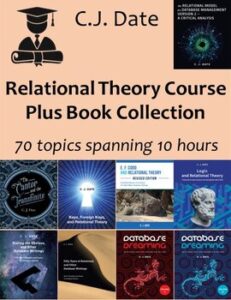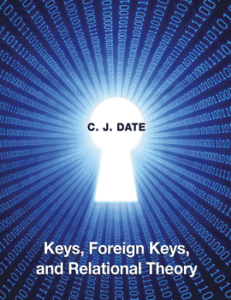The C.J. Date Relational Theory and Database Collection
PebbleU is our interactive platform where you can take courses and read our books on any device, as well as annotate, add bookmarks, and perform intelligence searches. A collection is a group of one or more books and courses that you can annually subscribe to on PebbleU. If a collection contains books, you will also receive PDF Instant Downloads of those books. New features weekly!

Relational Theory Course Plus Book Collection

In addition to receiving PDF copies of all nine of Date’s books, you will have one year of access to all of his books on PebbleU along with his relational theory course! Here is the course description:
There’s a great deal more to relational theory than most people realize. Of course, the relational model, which that theory is built on, is essentially quite simple—you can learn it pretty well in an hour or two, maybe less—but it has amazing depths, and implications that are yet to be fully explored. This one of a kind seminar examines some of those depths and implications. To set the scene, it opens with a preliminary overview of what the relational model and relational DBMSs are really all about—and even that overview might provide a few surprises, if your knowledge of such matters derives only from SQL. It then goes on to build on that foundation, taking closer looks at a series of important topics, including type theory, updating, language design, constraints, database design, views and view updating, temporal data, and missing information.
Top 5 reasons to take this course:
The Relational Model for Database Management Version 2

The relational model of data was invented by one man, E. F. (“Ted”) Codd, during his employment in the late 1960s and early 1970s at the IBM Research Laboratory in San Jose, California. Today, virtually all general purpose database systems are based on that model. But those systems are still a long way from perfect—and a major reason for this sorry state of affairs is that they none of them abide 100% by the prescriptions of the model. To address this problem, Codd subsequently wrote a book, The Relational Model for Database Management Version 2, in which he defined a hugely expanded version of his original model. His aim was to spell out, in vastly more detail than before, exactly what a relational database system is supposed to look like.
Given his track record, anything Codd has to say regarding database matters clearly deserves very careful attention and analysis—and that’s exactly what the present book provides regarding RM/V2 in particular: It describes, explains, and critiques Codd’s new model in all of its myriad aspects. The author, Chris Date, was a close colleague and supporter of Codd’s for many years and was instrumental in getting the word out regarding the original relational model.
Keys, Foreign Keys, and Relational Theory

Keys and foreign keys play a crucial role in relational databases—keys identify the objects of interest, and foreign keys knit those objects together. The basic idea couldn’t be simpler. As so often, however, the devil is in the detail … The fact is, these concepts aren’t quite as straightforward as they might seem on first acquaintance—or, at least, such would appear to be the case, if the literature is anything to go by. In this one of a kind book, noted database author C. J. Date traces the somewhat checkered history of the key and foreign key concepts, shedding some light on what turns out to be, on occasion, a surprisingly murky subject and explaining in detail what proper support should look like in true relational products.
Logic and Relational Theory

As a database professional, you owe it to yourself to understand the basics of formal logic, and you ought to be able to explain the connections between formal logic and database technology.
Fifty Years of Relational, and Other Database Writings

Fifty years of relational. It’s hard to believe the relational model has been around now for over half a century! But it has…
Stating the Obvious, and Other Database Writings
 Some things seem so obvious that they don’t need to be spelled out in detail. Or do they?
Some things seem so obvious that they don’t need to be spelled out in detail. Or do they?
Database Dreaming Volume I
 Along with its companion volume (Database Dreaming Volume II), this book offers a collection of essays on the general topic of relational databases and relational database technology.
Along with its companion volume (Database Dreaming Volume II), this book offers a collection of essays on the general topic of relational databases and relational database technology.
Database Dreaming Volume II
 Along with its companion volume (Database Dreaming Volume I), this book offers a collection of essays on the general topic of relational databases and relational database technology.
Along with its companion volume (Database Dreaming Volume I), this book offers a collection of essays on the general topic of relational databases and relational database technology.
E. F. Codd and Relational Theory, Revised Edition
 An examination of all of Codd’s major database publications, explaining the nature of his contribution in depth, and in particular highlighting not only the many things he got right but also some of the things he got wrong.
An examination of all of Codd’s major database publications, explaining the nature of his contribution in depth, and in particular highlighting not only the many things he got right but also some of the things he got wrong.
On Cantor and the Transfinite
 The aim of this book is to explain and investigate the claims of Cantor’s in depth (and question them, where appropriate). It’s not a textbook, though; instead, it’s a popular account—it tells a story—and the target audience is interested lay readers, not mathematicians or logicians.
The aim of this book is to explain and investigate the claims of Cantor’s in depth (and question them, where appropriate). It’s not a textbook, though; instead, it’s a popular account—it tells a story—and the target audience is interested lay readers, not mathematicians or logicians.
Please complete all fields.